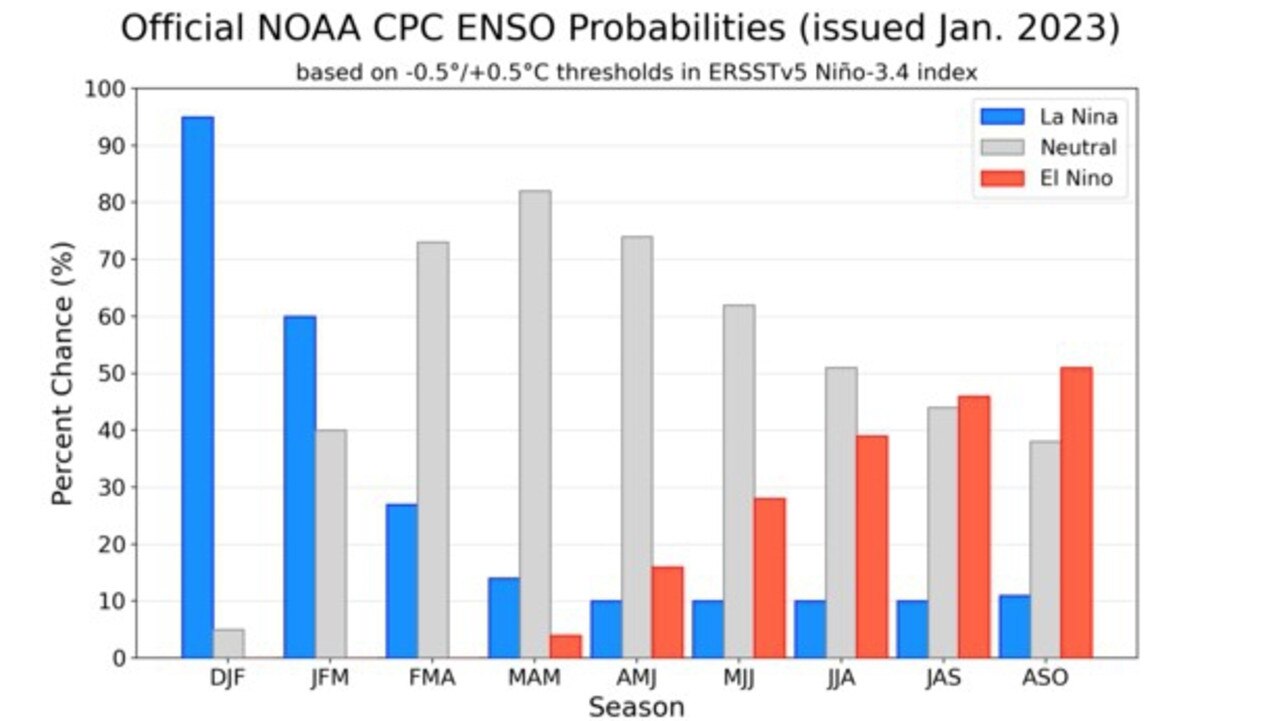Australia weather: BOM declares La Nina likely ‘near its end’
The climate driver that has led to years of drenching rains is “near its end”, the BOM has said. But that only brings new weather challenges.

READING LEVEL: GREEN
Laters La Nina*.
The Pacific Ocean* climate driver that has caused havoc* for three years, including delivering multiple deadly floods, is officially “near its end,” the Bureau of Meteorology* has declared.
The disappearance of La Nina will likely lead to far less moisture, particularly across Australia’s east.
And a swing back towards El Nino* will almost certainly bring warmer conditions. With all the lush* greenery years of rainfall has brought, there’s a potential for more bushfires too.
Although weather experts have said a return to drought* conditions might not be on the cards just yet.

La Nina is one extreme of the climate driver known as the El Nino – Southern Oscillation (ENSO).
During a La Nina phase, cool waters from the depths of the Pacific Ocean are hauled up to the surface around the equator*. Winds then push warmer seas towards Australia which aid in the creation of more clouds, moisture and windier conditions for the continent.
Conversely*, an El Nino can see Australia become far drier.
La Nina did tail off in January 2022, but then came back again later in the year. That’s unlikely to occur this time.

A climate driver update released by the Bureau of Meteorology on February 28 said La Nina was fading once more.
“La Nina has weakened in the tropical Pacific Ocean and is likely near its end,” the bureau stated.
“Ocean indicators of La Nina have returned to neutral* levels, while atmospheric indicators that remain at La Nina levels have started to weaken.”
The ENSO is measured chiefly from an area of the equatorial Pacific* known in the meteorological community as “Nino 3.4” which is south of Hawaii and close to Kiribati.
All but one of the main global climate models for surface temperatures in this zone are at a neutral level, meaning neither La Nina or El Nino has the upper hand.
The National Oceanic and Atmospheric Administration (NOAA) in the US has released its official predictions* for how ENSO will go up until October, with the increasing likelihood an El Nino will take over as we get deeper into the year.

The Bureau of Meteorology has forecast the ENSO will remain in neutral throughout autumn. But modelling can be less exact beyond that.
A neutral ENSO allows other climate drivers to get in on the action and affect Australia’s weather.
One of those is the Southern Annular Mode (SAM), a belt of winds that pushes up from Antarctica.
It’s currently in a positive mode, which decreases the chances of cold fronts pushing inland. But like ENSO it’s heading towards neutral. As is the Indian Ocean Diploe (IOD), which is similar to ENSO but off Australia’s west coast.
So what does this all mean for Australia’s weather over the coming months?
“From March to May, there are indications rainfall will generally be below average in the south and east, but above average for parts of the north,” the bureau said in a long range forecast from February.
“(The outlook is for) above average maximum temperatures for the southern two thirds of the nation.”
GLOSSARY
- La Nina: when tropical Pacific Ocean temperatures cool in the east and warm in the west
- Pacific Ocean: the largest and deepest ocean on Earth spanning more than 155 million square km from California to China
- havoc: situation where there is damage or destruction
- Bureau of Meteorology: Australia’s national weather, climate and water agency which provides regular weather forecasts, warning advice for floods, fires and storms
- El Nino: occurs when sea surface temperatures in the central and eastern tropical Pacific Ocean become substantially warmer than average and affects weather all over the world
- lush: growing thick and healthy
- drought: a continuous period of dry weather when an area gets less than its normal amount of rain
- equator: an imaginary line around the middle of a planet
- conversely: the opposite or on the other hand
- neutral: does not have any effect on other things
- equatorial Pacific: a key oceanographic region in Earth’s climate system
- predictions: a statement about what you think will happen in the future
EXTRA READING
La Nina to end after more rain
Aussie spirit shines through flood disaster
Long-range weather forecast lousy
QUICK QUIZ
- For how many years has the Pacific Ocean climate driver La Nina caused havoc?
- What happens during a La Nina phase?
- Is rainfall expected to be above or below average from March to May?
- What is ENSO an acronym for?
- What is the name given to a belt of winds that pushes up from Antarctica?
LISTEN TO THIS STORY
CLASSROOM ACTIVITIES
1. Design a Diagram Design diagrams that will help younger kids understand the difference between El Nino and La Nina.
Time: allow 45 minutes to complete this activity.
Curriculum Links: English, Science, Geography
2. Extension
Do you know how meteorologists make their predictions about the weather? Use information in the story and your own research skills to write a report on this question.
Time: allow 60 minutes to complete this activity.
Curriculum Links: English, Science, Geography.
VCOP ACTIVITY
I spy nouns
Nouns are places, names (of people and objects), and time (months or days of the week).
How many nouns can you find in the article?
Can you sort them into places, names and time?
Pick three nouns and add an adjective (describing word) to the nouns.


